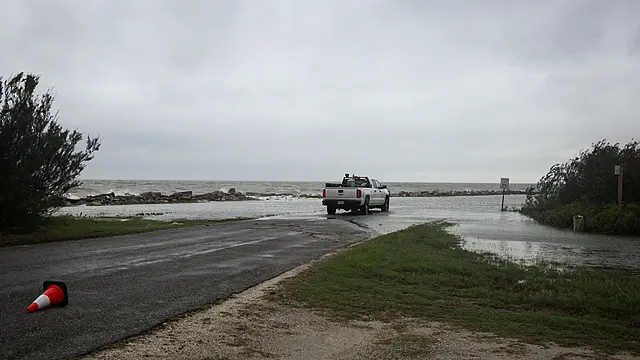Beta made landfall late on Monday as a tropical storm just north of Port O’Connor, and has the distinction of being the first time a storm named for a Greek letter made landfall in the continental US.
Forecasters ran out of traditional storm names last week, forcing the use of the Greek alphabet for only the second time since the 1950s.
Beta was east-north-east of Victoria, Texas, with maximum winds of 35mph, the US National Hurricane Centre said, and is moving towards the north east.
“We currently have both storm surge and rainfall going on right now,” said National Weather Service meteorologist Amaryllis Cotto in Galveston.
She said 6in to 12in of rain has fallen in the area, with isolated amounts of up to 18in. Dangerous flash flooding is expected until Wednesday, she added.
Beta was the ninth named storm to make landfall in the continental US this year, tying a record set in 1916, according to Colorado State University hurricane researcher Phil Klotzbach.
4 AM CDT Tuesday, September 22 Key Messages for Tropical Storm #Beta. Significant flash and urban flooding is occurring and will continue near the middle and upper Texas coast today. https://t.co/pWVN7x5qij pic.twitter.com/dvaxL9A59u
— National Hurricane Center (@NHC_Atlantic) September 22, 2020
Beta was forecast to eventually move over Louisiana and Mississippi on Wednesday night, and the biggest unknown is how much rainfall it could produce.
Flash flooding is possible in Arkansas, Louisiana and Mississippi as the system moves further inland.
Earlier predictions of up to 20in of rain in some areas were downgraded on Monday to up to 15in.
Forecasters and officials reassured residents that Beta was not expected to be another Hurricane Harvey or Tropical Storm Imelda. Harvey dumped more than 50in of rain on Houston in 2017, causing 125 billion dollars in damage in Texas. Imelda, which hit south-east Texas last year, was one of the wettest cyclones on record.
Storm surge up to 4ft is possible in the Galveston and Beaumont areas until Wednesday morning, forecasters said.
In Galveston, an island city south east of Houston, there was already some street flooding from rising tides and part of a popular fishing pier collapsed due to strong waves.
Issuing a Disaster Declaration for 29 Texas counties in the path of #TropicalStormBeta.
This storm is expected to make landfall this evening and has already caused storm surge and damaging winds along the Texas Coast.https://t.co/oZ3B2ORYJW— Gov. Greg Abbott (@GovAbbott) September 21, 2020
On Monday, state governor Greg Abbott issued a disaster declaration for 29 Texas counties ahead of Beta’s arrival.
Beta is also forecast to dump heavy rain on the south-western corner of Louisiana three weeks after the same area got pounded by Hurricane Laura.
The rainfall and storm surge prompted governor John Bel Edwards to declare a state of emergency.
Meanwhile, Hurricane Teddy is continuing its path towards Canada, with a predicted landfall in Nova Scotia early on Wednesday before moving into Newfoundland on Wednesday night, forecasters said.
The large and powerful storm is causing dangerous rip currents along the US East Coast, and tropical storm conditions are expected to begin in Nova Scotia by Tuesday afternoon.







